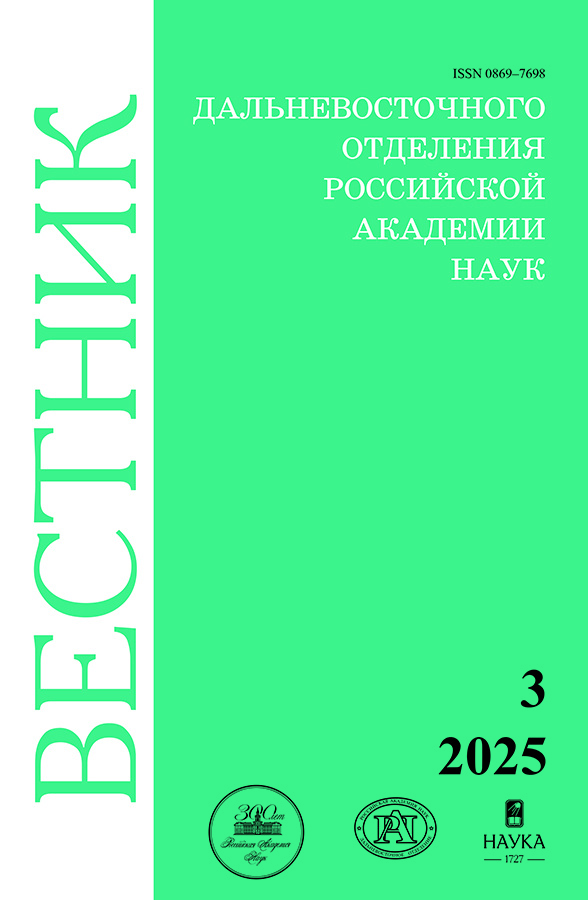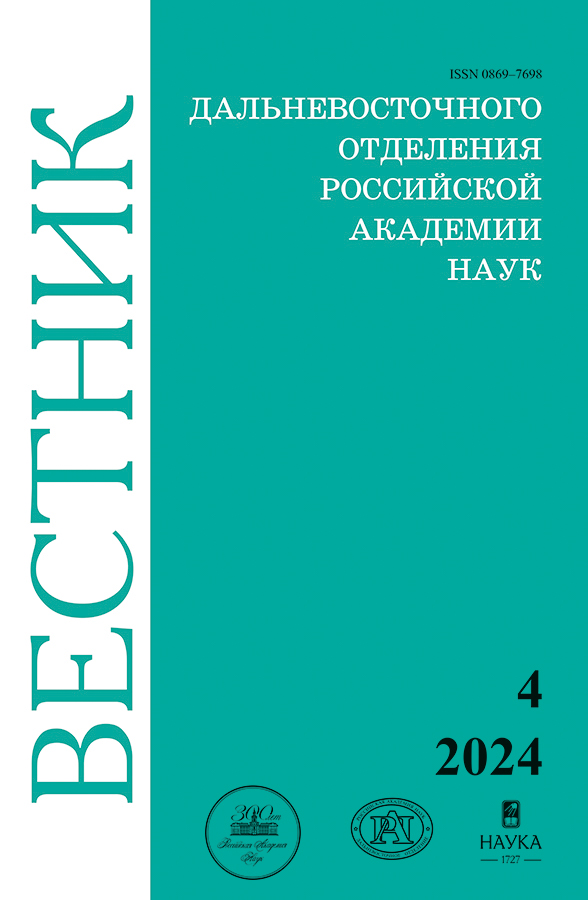Diffiiculties in the anthropogenic concept of global warming and the seismogenic trigger mechanism of climate change
- Authors: Lobkovsky L.I.1,2, Semiletov I.P.3,2, Baranov A.A.4, Vladimirova I.S.1
-
Affiliations:
- Shirshov Institute of Oceanology of the Russian Academy of Scieces
- Sakhalin State University/SakhTECH
- V. I. Il’yichev Pacific Oceanological Institute, FEB RAS
- Institute of Earthquake Prediction Theory and Mathematical Geophysics, RAS
- Issue: No 4 (2024)
- Pages: 44-59
- Section: Earth and Environment Sciences
- URL: https://permmedjournal.ru/0869-7698/article/view/676037
- DOI: https://doi.org/10.31857/S0869769824040022
- EDN: https://elibrary.ru/IRKHNM
- ID: 676037
Cite item
Full Text
Abstract
Diffiiculties in the anthropogenic concept of global warming are discussed and a seismogenic trigger mechanism for climate change is proposed.The essence of this mechanism is that methane contained in the micropores of frozen rocks in a locked state can be released as a result of the destruction of the microstructure of the environment due to additional stresses caused by the trigger effect of deformation waves passing through gas-saturated areas of sedimentary strata. The waves themselves are generated by the strongest earthquakes that occur in subduction zones. With a characteristic speed of deformation waves of the order of 100 km/year, they travel a distance of about 2000–2500 km from the Aleutian and Kuril-Kamchatka subduction zones to the Arctic zone in approximately 20–25 years. This corresponds to the time difference between a series of the most powerful earthquakes with a magnitude greater than 8.5, which occurred in these zones in the interval 1952–1965, and the beginning of a sharp climate warming in 1980. After the start of the gas filtration process as a result of the destruction of the pore microstructure and a sharp increasing the permeability of the geomedium due to the impact of a deformation wave, the process of methane emission can continue autonomously for tens and even hundreds of years, depending on the thickness of the disturbed gas-saturated layer. This explains the ongoing emission of methane on the Arctic shelf for the last forty-odd years after the strongest earthquakes of the middle of the last century that initiated it.
Full Text
About the authors
Leopold I. Lobkovsky
Shirshov Institute of Oceanology of the Russian Academy of Scieces; Sakhalin State University/SakhTECH
Email: llobkovsky@ocean.ru
ORCID iD: 0000-0002-8033-8452
Academician of RAS, Doctor of Sciences in Physics and Mathematics, Professor, International Center of the Far-Eastern and Arctic Seas (named by admiral S.O. Makarov)
Russian Federation, Moscow; Yuzhno-SakhalinskIgor P. Semiletov
V. I. Il’yichev Pacific Oceanological Institute, FEB RAS; Sakhalin State University/SakhTECH
Email: ipsemiletov@gmail.com
ORCID iD: 0000-0003-1741-6734
Corresponding Member of RAS, Doctor of Sciences in Geology and Mineralogy, Professor, International Center of the Far-Eastern and Arctic Seas (named by admiral S.O. Makarov)
Russian Federation, Vladivostok; Yuzhno-SakhalinskAlexey A. Baranov
Institute of Earthquake Prediction Theory and Mathematical Geophysics, RAS
Author for correspondence.
Email: aabaranov@gmail.com
ORCID iD: 0000-0002-7793-5555
Candidate of Sciences in Physics and Mathematics
Russian Federation, MoscowIrina S. Vladimirova
Shirshov Institute of Oceanology of the Russian Academy of Scieces
Email: vladis@gsras.ru
ORCID iD: 0000-0002-7301-7183
Candidate of Sciences in Physics and Mathematics
Russian Federation, MoscowReferences
- Danilov-Danilyan V.I., Kattsov V. M., Porfiryev B. N. Ecology and climate: where we are now and where we will be in two or three decades. The situation in Russia. Bulletin of the Russian Academy of Sciences. 2023;93(11):1032–1046. (In Russ.).
- Neukom R., Barboza L. A., Erb M. P., Shi Feng, Emile-geay J., Evans M. N. et al. 2019. Global mean temperature reconstructions over the Common Era. figshare. Collection. 4507043.v2. https://doi.org/10.6084/m9.figshare.
- AGES2k Consortium. A global multiproxy database for temperature reconstructions of the Common Era. Scientific Data 4. 2017. 170088 EP. https://doi.org/10.1038/sdata.2017.88.
- PAGES2k Consortium. Consistent multidecadal variability in global temperature reconstructions and simulations over the Common Era. Nat. Geosci. 2019;12:643–649. https://doi.org/10.1038/s41561-019-0400-0.
- Houghton J. T., Jenkins G. J.,Ephraums J.J. (eds.). IPCC Scientific Assessment 1990: Climate Change 1990. Cambridge, Great Britain;New York, NY, USA; Melbourne, Australia: Cambridge University Press; 1990. 410 p.
- Watson R. T. and the Core Writing Team (eds.). IPCC, 2001: Climate Change 2001: Synthesis Report. A Contribution of Working Groups I, II, and III to the Third Assessment Report of the Integovernmental Panel on Climate Change. Cambridge, United Kingdom; New York, NY, USA: Cambridge University Press; 2001. 398 p.
- Moberg A., Sonechkin D., Holmgren K. et al. Highly variable Northern Hemisphere temperatures reconstructed from low- and high-resolution proxy data. Nature. 2005;433:613–617. https://doi.org/10.1038/nature03265.
- Lamb H. H. The early medieval warm epoch and its sequel. Palaeogeogr. Palaeoclimatol. Palaeoecol. 1965;1:13–37.
- Mann M. E., Bradley R. S., Hughes M. K. Global-Scale Temperature Patterns and Climate Forcing Over the Past Six Centuries. Nature. 1998;392:779–787.
- Masson-Delmotte V., Schulz M., Abe-Ouchi A., Beer J., Ganopolski A., González Rouco J. F., Jansen E., Lambeck K., Luterbacher J., Naish T., Osborn T., Otto-Bliesner B., Quinn T., Ramesh R., Rojas M., Shao X., Timmermann A. Information from Paleoclimate Archives. In: Stocker T. F., Qin D., Plattner G.-K., Tignor M., Allen S. K., Boschung J., Nauels A., Xia Y., Bex V., Midgley P. M. (eds.). Climate Change 2013: The Physical Science Basis. Contribution of Working Group I to the Fifth Assessment Report of the Intergovernmental Panel on Climate Change. 2013. Cambridge, United Kingdom; New York, NY, USA: Cambridge University Press.
- Friedlingstein P., O‘Sullivan M., Jones M. W. et al. Global Carbon Budget 2022. Earth Syst. Sci. Data. 2022;14:4811–4900. https://doi.org/10.5194/essd-14-4811-2022.
- Lobkovsky L. I. Seismogenic-triggering mechanism of gas emission activizations on the Arctics helf and associated phases of abrupt warming. Geosciences. 2020;10:428.
- Lobkovsky L. I., Baranov A. A., Ramazanov M. M., Vladimirova I. S.,Gabsatarov Y.V., Semiletov I. P., Alekseev D. A. Trigger Mechanisms of Gas Hydrate Decomposition, Methane Emissions, and Glacier Breakups in Polar Regions as a Result of Tectonic Wave Deformation. Geosciences. 2022;12:372.
- Lobkovsky L. I., Baranov A. A., Garagash I. A., Ramazanov M. M., Vladimirova I. S., Gabsatarov Y. V., Alekseev D. A., Semiletov I. P. Large Earthquakes in Subduction Zones around the Polar Regions as a Possible Reason for Rapid Climate Warming in the Arctic and Glacier Collapse in West Antarctica. Geosciences. 2023;13:171.
- Climate at a Glance: Global Time Series. NOAA National Centers for Environmental information. URL: https://www.ncei.noaa.gov/cag/ (date of application: 15.09.2022).
- Lay T. The surge of great earthquakes from 2004 to 2014. Earth and Planetary Science Letters. 2015;409:133–146.
- Shakhova N. E., Semiletov I. P. Methane Hydrate Feedbacks. In: Martin Sommerkorn, Susan Joy Hassol (eds.). Arctic Climate Feedbacks: Global Implications. Published by WWF International Arctic Programme August, 2009. P. 81–92. ISBN: 978-2-88085-305-1.
- Shakhova N., Semiletov I., Salyuk A., Yusupov V., Kosmach D., Gustafsson O. Extensive Methane Venting to the Atmosphere from Sediments of the East Siberian Arctic Shelf. Science. 2010;327(5970):1246–1250. doi: 10.1126/science.1182221.
- Shakhova N., Semiletov I., Leifer I., Sergienko V., Salyuk A., Kosmach D., Chernikh D., Stubbs C., Nicolsky D., Tumskoy V., Gustafsson O. Ebullition and storm-induced methane release from the East Siberian Arctic Shelf. Nat. Geosci. 2014;7(1):64–70. doi: 10.1038/ngeo2007, 2014.
- Shakhova N., Semiletov I., Sergienko V., Lobkovsky L., Yusupov V., Salyuk A., Salomatin A., Chernykh D., Kosmach D., Panteleev G., Nicolsky D., Samarkin V., Joye S., Charkin A., Dudarev O., Meluzov A., Gustafsson Ö. The East Siberian Arctic Shelf: towards further assessment of permafrost-related methane fluxes and role of sea ice. Phil. Trans. R. Soc. A. 2015;373. 20140451. doi: 10.1098/rsta.2014.0451.
- Chernykh D., Shakhova N., Yusupov V., Gershelis E., Morgunov B., Semiletov I. First Calibrated Methane Bubble Wintertime Observations in the Siberian Arctic Seas: Selected Results from the Fast Ice.Geosciences. 2023;13. 228. https://doi.org/10.3390/geosciences13080228.
- Shakhova N., Semiletov I., Chuvilin E. Understanding the permafrost–hydrate system and associated methane releases in the East Siberian Arctic Shelf. Geosciences. 2019;9.251. doi: 10.3390/geosciences9060251.
- Nicolsky D. J., Romanovsky V. E., Romanovskii N. N., Kholodov A. L., Shakhova N. E., Semiletov I. P. Modeling sub-sea permafrost in the East Siberian Arctic Shelf: The Laptev Sea region. J. Geophys. Res. 2012;117. F03028. doi: 10.1029/2012JF002358, 2012.
- Romanovskii N. N., Hubberten H.-W., Gavrilov A. V., Eliseeva A. A., Tipenko G. S. Offshore permafrost and gas hydrate stability zone on the shelf of East Siberian Seas. Geo-Mar. Lett. 2005;25:167–182.
- Shakhova N., Semiletov I., Gustafsson O., Sergienko V., Lobkovsky L., Dudarev O., Tumskoy V., Grigoriev M., Mazurov A., Salyuk K. et al. Current rates and mechanisms of subsea permafrost degradation in the East Siberian Arctic Shelf. Nat. Commun. 2017;8. 15872.
- Lobkovsky L. I., Baranov A. A., Bobrov A. M., Chuvaev A. V. Global geodynamic model of the modern Earth and its application for the Arctic region. Reports of the Russian Academy of Sciences. 2024. (In Russ.). doi: 10.1134/S1028334X23603000.
- Garagash I. A., Lobkovsky L. I. Deformation tectonic waves as a possible trigger mechanism for intensifying methane emissions in the Arctic. Arctic: Ecology and Economics. 2021;1(1):42–50. (In Russ.).
- Lobkovsky L. I., Ramazanov M. M. Thermomechanical waves in the system elastic lithosphere–viscous asthenosphere. Bulletin of the Russian Academy of Sciences. Mechanics of Liquid and Gas. 2021;(6):4–18. (In Russ.).
- Lobkovsky L. I., Baranov A. A., Vladimirova I. S., Gabsatarov Yu. V., Alekseev D. A. Possible seismogenic trigger mechanism for methane emission, glacier destruction and climate warming in the Arctic and Antarctic. Physics of the Earth. 2023;(3):33–47.
- Lan X.,Thoning K.W., Dlugokencky E. J. Trends in globally-averaged , , and determined from NOAA Global Monitoring Laboratory measurements. 2015. Version 2023-02. https://doi.org/10.15138/P8XG-AA10.
- Dlugokencky E. J., Steele L. P., Lang P. M., Masarie K. A. The growth rate and distribution of atmospheric methane. J. Geophys. Res. 1994;99:17021–17043. https://doi.org/10.1029/94JD01245.
- Lobkovsky L. I., Baranov A. A., Vladimirova I. S., Alekseev D. A. Strong earthquakes and deformation waves as possible triggers of climate warming in the Arctic and destruction of glaciers in the Antarctic. Bulletin of the Russian Academy of Sciences. 2023;93(6):526–538. (In Russ.).
- Lobkovsky L. I., Ramazanov M. M. On the theory of filtration with double porosity. Reports of the Russian Academy of Sciences. Geosciences. 2019;484(3):348–351. (In Russ.).
- Lobkovsky L. I., Ramazanov M. M. Generalized model of filtration in a fractured-porous medium with low-permeability inclusions and its possible applications. Physics of the Earth.2022;(2):144–154. (In Russ.).
- Minoura K., Imamura F., Sugawara D., Kono Y., Iwashita T. The 869 Jogan tsunami deposit and recurrence interval of large-scale tsunami on the Pacific coast of northeastern Japan. J. Nat. Disaster Sci. 2001;23(2):83−88.
- Ozawa S., Nishimura T., Suito H., Kobayashi T., Tobita M., Imakiire T. Coseismic and postseismic slip of the 2011 magnitude-9 Tohoku-Oki earthquake. Nature. 2011;475:373–377.
- McCaffrey R. Global frequency of magnitude 9 earthquakes. Geology. 2008;36(3):263–266.
- Satake K., Atwater B. F. Long-term perspectives on giant earthquakes and tsunamis at subduction zones. Annu. Rev. Earth Planet. Sci. 2007;35:349–374.
- Rajendran K. On the recurrence of great subduction zone earthquakes. Current Science. Special section: Earth Sciences. 2013;104(7):880–892.
- Shennan I., Barlow N., Carver G., Davies F., Garrett E., Hocking E. Great tsunamigenic earthquakes during the last 1000 years on the Alaska megathrust. Geology. 2014;42(8):687–690.
Supplementary files















